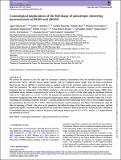Por favor, use este identificador para citar o enlazar a este item:
http://hdl.handle.net/10261/296573COMPARTIR / EXPORTAR:
 SHARE SHARE
 CORE
BASE CORE
BASE
|
|
| Visualizar otros formatos: MARC | Dublin Core | RDF | ORE | MODS | METS | DIDL | DATACITE | |

| Título: | Cosmological implications of the full shape of anisotropic clustering measurements in BOSS and eBOSS |
Autor: | Semenaite, Agne; Sánchez, Ariel G.; Pezzotta, Andrea CSIC ORCID; Hou, Jiamin; Scoccimarro, Román CSIC; Eggemeier, Alexander; Crocce, Martín CSIC ORCID; Chuang, Chia-Hsun; Smith, Alex; Zhao, Cheng; Brownstein, Joel R.; Rossi, Graziano; Schneider, Donald P. | Palabras clave: | Cosmological parameters Large-scale structure of the universe |
Fecha de publicación: | 2022 | Editor: | Oxford University Press | Citación: | Monthly Notices of the Royal Astronomical Society 512(4): 5657-5670 (2022) | Resumen: | We present the analysis of the full shape of anisotropic clustering measurement from the extended Baryon Oscillation Spectroscopic Survey (eBOSS) quasar sample together with the combined galaxy sample from the Baryon Oscillation Spectroscopic Survey (BOSS), re-analysed using an updated recipe for the non-linear matter power spectrum and the non-local bias parameters. We obtain constraints for flat Lambda cold dark matter cosmologies, focusing on the cosmological parameters that are independent of the Hubble parameter h. Our recovered value for the Root Mean Square (RMS) linear perturbation theory variance as measured on the scale of 12Mpc is σ12 = 0.805 ± 0.049, while using the traditional reference scale of 8h−1Mpc gives σ8 = 0.815 ± 0.044. We quantify the agreement between our measurements and the latest cosmic microwave background data from Planck using the suspiciousness metric, and find them to be consistent within 0.64 ± 0.03σ. Combining our clustering constraints with the 3 × 2pt data sample from the Dark Energy Survey Year 1 release slightly degrades this agreement to the level of 1.54 ± 0.08σ, while still showing an overall consistency with Planck. We furthermore study the effect of imposing a Planck – like prior on the parameters that define the shape of the linear matter power spectrum, and find significantly tighter constraints on the parameters that control the evolution of density fluctuations. In particular, the combination of low-redshift data sets prefers a value of the physical dark energy density ωDE = 0.335 ± 0.011, which is 1.7σ higher than the one preferred by Planck. | Versión del editor: | https://doi.org/10.1093/mnras/stac829 | URI: | http://hdl.handle.net/10261/296573 | DOI: | 10.1093/mnras/stac829 | E-ISSN: | 1365-2966 |
| Aparece en las colecciones: | (ICE) Artículos |
Ficheros en este ítem:
| Fichero | Descripción | Tamaño | Formato | |
|---|---|---|---|---|
| cosmoloboss.pdf | 2,61 MB | Adobe PDF |  Visualizar/Abrir |
CORE Recommender
SCOPUSTM
Citations
26
checked on 25-abr-2024
WEB OF SCIENCETM
Citations
21
checked on 18-feb-2024
Page view(s)
26
checked on 22-may-2024
Download(s)
18
checked on 22-may-2024
Google ScholarTM
Check
Altmetric
Altmetric
Este item está licenciado bajo una Licencia Creative Commons

